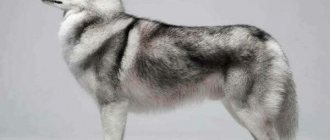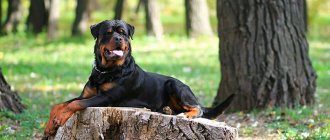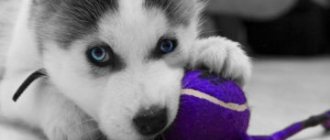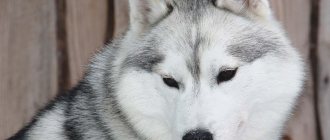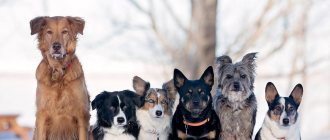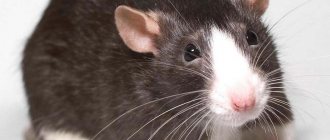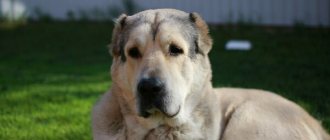Many people remember very well Glyukoza’s cartoon clip about the bride, where a cartoon teenage girl easily manages a large and majestic dog on a walk. This dog is a Doberman Pinscher breed. This breed will be discussed in the article.
A young breed developed in the second half of the 19th century and named after the breeder Louis Doberman. Carrying out numerous searches to obtain a dog that, becoming an excellent protector for the owner, would retain the elegance of its appearance.
Louis had to cross four breeds: a miniature pinscher, a Rottweiler, an English greyhound, and a German shepherd. There is a little bit of admixture from other breeds, but these breeds have given the main traits to this strong dog. Typically, dogs of this breed are used for service purposes. Very smart, easy to train, unrivaled guards. Their appearance is menacing and intimidating, but their disposition is very friendly, although they are always serious. They love to chase and drive the pursued object into a corner, where, without attacking, they will hold it until the owner arrives.
Doberman Pinscher
A very large animal, with a well-developed, muscular body. A healthy animal will delight its owner with its presence in his life for 8 - 12 years. Males in adulthood reach large sizes, their height at the withers is 68 - 72 cm, ladies are slightly smaller and are 63-68 cm at the withers.
Fit, with long graceful paws, the weight of an adult Doberman male reaches 40-45 kg; females are lighter and usually weigh no more than 35 kg. The best representatives of the breed are dogs with average performance.
The proud posture of the animal is added by cropped ears, which give it a special, intimidating appearance. Ear cutting is performed on puppies at 7-8 weeks of age. The coat color is usually brown or black. Dobermans are smooth-haired dogs. Their fur fits so tightly to the body that it shines in the sun in different colors. The presence of undercoat is not allowed. They always have red tan markings located above the eyes, on the chest, cheeks, paws and under the tail. According to the standard, the head from above should look like a blunt wedge.
A standard table has been adopted, according to which puppies of the breed in question should gain weight by month. In order for your pet to meet the standards, you need to carefully monitor the diet and select nutrition. Puppies grow very quickly, increasing in size several times each month.
| Boys: | Girls: | |
| 1 month | 3.8 kg | 3.5 kg |
| 2 month | 8.7 kg | 7.8 kg |
| 3 month | 14 kg | 12.3 kg |
| 4 month | 18.5 kg | 16.5 kg |
| 5 month | 22.5 kg | 20.3 kg |
| 6 month | 26 kg | 23 kg |
| 7 month | 27.5 kg | 24.5 kg |
| 8 month | 29.5 kg | 25.6 kg |
| 9 month | 31.2 kg | 26.6 kg |
| 10 month | 33 kg | 27.5 kg |
| 11 month | 34 kg | 28 kg |
| 12 month | 35 kg | 29 kg |
Overweight of the animal should also not be allowed. If this happens, it is necessary to transfer him to dietary nutrition.
Principles of weighing a dog
Determining the weight of a pet with accuracy is a difficult matter, since it is usually not always possible to keep the dog in one place, especially a playful puppy. The simplest home weighing method is to separately determine your weight and the weight with the puppy in your arms. Then calculate the difference. The resulting number is the weight of the pet.
Another way of weighing is to involve the dog using a treat. But again, the puppy may not respond to commands, making it difficult to determine its weight.
The last method involves hanging the dog on a dynamometer scale. This is done quite simply; the Doberman can be dressed in a suit and hung by a strap, but in such a way that the pet does not feel uncomfortable.
Miniature Pinscher Miniature Doberman
Despite the name "dwarf Doberman", the miniature pinscher is not an exact copy of the Doberman in a smaller form. Referring to an independent breed of dogs, they are united with the Doberman by one common ancestor of the smooth-haired pinscher breed. This is where the similarities end. This breed has a second name - miniature pinscher. The Miniature Pinscher is a breed older than the Doberman Pinscher. Its origin dates back to the 15th century.
A born hunter, with sensitive hearing and an excellent sense of smell, he will perfectly cope with the role of a devoted friend in the family and a reliable guard. A smart dog, even as a puppy, will figure out who is prey and who is master and friend, and does not need long and tedious explanations. Hunting instincts are perfectly preserved, even if the animal lives in an urban environment.
At the end of the 19th century, the miniature pinscher standard was determined. An animal with a muscular body, an elongated muzzle and powerful jaws. They have a thin but very strong neck, medium-sized and erect ears. Very proportional dogs, at sexual maturity reaching a height of 25-30 cm at the withers for males, females are a couple of centimeters lower. The weight of an adult dog is 4-6 kg. In males, girls weigh less. Despite its modest size, this is a very strong breed of dog. The coat is smooth, dense, and the color is brown, or less commonly black and tan. The life expectancy of little hunters reaches 15 years.
Puppies grow very smoothly, gradually gaining weight over the months:
| Age: | Weight: |
| 1 month | 0.65 kg |
| 2 months | 1.1 kg |
| 3 months | 1.5 kg |
| 4 months | 1.9 kg |
| 5 months | 2.3 kg |
| 6 months | 2.5 kg |
| 12 months | 4 kg |
Description of the breed
The history of Doberman breeding begins at the end of the 19th century. Despite the fact that the breed was bred recently, its creation is shrouded in a fog of mysteries and secrets . This is due to the fact that the author did not leave any notes about the selection process. Therefore, his followers could only guess in the features of the Doberman his ancient ancestors.
Friedrich Louis Dobermann is the creator of this unusual breed. He lived in Germany, worked as a tax collector during the day and as a policeman at night. As you can imagine, not everyone wanted to pay taxes, and Mr. Dauberman had to think about how to make his work as efficient as possible and protect himself from conflict situations with aggressive debtors, because he always carried large sums of money with him.
Already in the 1870s. Dogs that Mr. Dobermann called Thuringian Pinschers . They gained wide popularity among residents of the city of Apolda, and then beyond its borders. They were purchased to assist police officers, as watchmen and bodyguards.
Word of the fearless and loyal Thuringian Pinscher spread at the speed of light thanks to the fact that Mr. Dobermann's dogs actually brought great practical benefits . They could engage in various types of activities, had super-fast reactions and lightning speed, were hardy and not picky in terms of care.
If your Doberman puppy is not gaining weight
The current weight gain standard for Doberman Pinschers is the same for all dogs of this breed. As the puppy develops, it should gain weight proportionately. If the pet deviates from the set rate of weight gain, the owner should pay attention to this and monitor the dog’s behavior.
Abnormalities in weight gain can be a sign of certain diseases, but not always. Active animals that love to run and whose owners spend a lot of time walking with them gain weight more slowly.
Climate also affects this indicator. It is necessary to ensure that the puppy receives enough calcium from its diet. Infectious and viral diseases can prevent weight gain. The presence of worms is always the reason for slow weight gain.
What influences development?
There are many factors that influence the height and weight of a Doberman puppy.:
- Nutrition . It must be rational, balanced, and its amount must strictly correspond to age. A Doberman puppy's diet should contain a minimum of fried and fatty foods, as well as a small amount of carbohydrates. Sweets and flour products are also undesirable, and overfeeding is unacceptable.
- Disease is another factor that affects the normal development, weight gain and growth of a pet. These could be hormonal disorders, allergic reactions, or the presence of parasites. But don't rush to conclusions. If you suspect your puppy is sick, consult a professional.
- Genetic factor . Sometimes puppies are born underweight, and sometimes they tend to be overweight. If this is so, then underweight or overweight can be attributed to the natural constitution of the animal and it is almost impossible to correct the situation. However, in order to make a final conclusion, it is necessary to consult with specialists. You may need to take tests or conduct other studies.
- Climacteric region . It happens that because the climate is too cold or hot, the dog will gain or lose weight so that it does not meet classical standards. If this is the only reason, there is no reason to worry.
How to gain weight for a Doberman puppy
A healthy dog has an excellent appetite, and the rate of weight gain directly depends on the diet of the growing dog. You cannot feed your dog raw meat. It is necessary to take into account that the animal is very large, and eating raw meat leads to increased aggressiveness. The best diet would be dry food. About half a kilogram of food per day will provide your pet with the necessary microelements.
You can feed a Doberman with natural food, but you need to take into account some features. Pork is not the best food for these dogs, at least lean.
By-products can be given, but after reaching 6 months. An excellent diet would be a diet with a predominance of dairy products: cottage cheese, kefir, yogurt. Dobermans love raw eggs and fish. Giants really need microelements, of which there are many in cereals: millet, oatmeal, rice and buckwheat will perfectly compensate for their deficiency. Vitamin supplements should be added to the diet with natural food.
To what age do they grow?
Before answering this question, it should be said that the growth and development of a puppy is conventionally divided into five stages. And each of them deserves special attention.
Doberman growth stages:
- Period of intrauterine development . This period is considered fundamental, since it is at this moment that the genetics and innate characteristics of the puppy are laid down. That’s why when purchasing, you should always pay attention to the parents, their appearance, character, size, weight and other data.
- Milk period or breastfeeding period . As a rule, it lasts from 1.5 to 2 months. During this period, the baby’s immunity is formed, and the breeder is entirely responsible for his health.
- The third stage is the period of physical maturation (from 2 to 6 months) . At this time, the baby is taken away from the mother and handed over to permanent owners. This is the most intense period of growth, development, maturation. Therefore, at this time it is very important to feed the puppy with high-quality balanced food and provide him with proper care and maintenance. It is also during this period that you should begin to seriously train your dog.
- The fourth stage is the period of growing up (from 6 to 12 months) : Doberman puppies continue to actively grow and gain weight, right now the puppy is turning into an adult dog. By the end of this period, height and weight gain stops.
- The fifth stage is the end of formation (from 1 to 2 years) . At this stage, the dog’s exterior is fully formed and muscle mass has been gained.
Thus, we can conclude that the growth and formation of the Doberman cannot be called complete before the age of 2 years.
How to dial and measure height correctly
It is not on a whim that breeders instill certain standard traits into dogs, for which strict parameters are established. The presence of these features helps animals cope with the main tasks of their breeding, i.e. security functions, hunting, decorative.
Accordingly, parameters for measuring standardized indicators and special tools for making measurements have been established. The most accurate measurements are taken with a rigid measuring stick. A less accurate tool, where the error increases, includes a flexible measuring tape.
A book or any flat object is applied to the withers of a dog standing on a flat, level surface, while its head should be raised and its neck straightened. A flat object located at the withers is pressed against the wall at one end and a mark is made at this level (approximately the way we were measured in childhood).
The resulting level is measured with any of the above instruments. The greatest accuracy is obtained by measurements taken three times.
Features of maintenance and care
Initially, this breed was bred in Thuringia (Germany), where the climate is mild. As a result of selection, they inherited a hard outer coat without undercoat and a dry, muscular body. They lived mainly outdoors - in enclosures. With the spread of Thuringian dogs around the world, the living conditions have changed - in our climate they are cold. In winter, in cold weather, and during long walks, they need to be insulated. Previously, owners had to sew their pets' clothes to order or share their own (by the way, size 44 is quite suitable for a male)).
In addition, during icy conditions, roads are sprinkled with reagents and industrial salt, which cause irritation, injure the pads of the toes, and can cause burns or allergies. This antifreeze is dangerous even after the ice melts - no one removes it from the road. Therefore, residents of large cities began to put shoes on their pets. Now this is not a problem - special shoes are produced industrially and sold in pet stores.
Place of detention
The Doberman is more suited to being kept in the owner's home.
Photo: Tim Johnson In our latitudes, Dobermans are often kept in houses and apartments, although if you have a warm heated kennel and an insulated enclosure, they can sometimes be kept in an enclosure. If you plan to keep it in an enclosure, it is better to accustom the puppy to this from childhood. The enclosure is built large, taking into account the size of the adult individual. There are no difficulties with heating the Doberman in the apartment. And this breed needs the owner’s proximity too much to keep him alone. When kept in an enclosure without proper communication and work, it becomes “lobbery” and becomes stupid.
Feeding
It should be noted that puppies should immediately begin to be fed from a stand located at the height of the dog’s chest. This is done so as not to spoil the dog’s posture. There are different types of stands, it is easy to make it yourself, changing the height as the dog grows. Puppies up to six months are fed up to 6 times a day, adolescents - 4 times. Adults receive food 2 times a day (but never mind refueling with a tasty treat from the master's table). Clean water must be constantly available. The food is given warm.
Briefly about the main thing
- The ferocious appearance of the Doberman is just a frightening picture. Of course, he is a very strong animal, capable of protecting his owner to the end, but by his nature he is friendly and accommodating.
- They will make great friends for teenagers and get along well with smaller animals in the house. They love communication very much, and even need it. Owners must allocate enough time to communicate with their pet.
- Smart, easily trained dogs, designed for human protection.
- An interesting fact about the miniature pinscher: racing over huge distances is the norm for them, because they used to accompany carts with horses to protect the property of their owners.
- An excellent mole and rat catcher.
- Its modest size is complemented by the complex character and abilities of a security guard.
- Already as a puppy, he should know that the owner is in charge.
- Active, playful, friendly, but with dignity. They cannot stand violation of their boundaries and pain.
- Capable of barking until they are hoarse.
Education and training
Teaching a Doberman is a pleasure. They often remember commands the first or second time and do not confuse them. They are engaged enthusiastically, joyfully, the attention of the owner delights them. They can take risks to please their owner. If you disobey, it is enough to pretend that you are leaving, and the stubbornness will no longer exist. The owner is their sun, and they “revolve” only around him. Only a bitch “in heat” can make a Doberman male forget himself for a while, and not for everyone and not always.
Raising a puppy
Training and raising a puppy should begin at about 2 months, when he gets home. You need to treat him kindly, repeating your demands several times without changing them and always insisting on fulfillment. He will very quickly understand his nickname, place, daily routine. With an attentive and patient attitude towards the baby, already at 2-3 months he is quite capable of mastering the rules of behavior and some simple commands:
- sit
- lie
- place
- eat, etc.
Photo: PiscesTiger24 The main thing is not to overload him (the lesson lasts 3-4 minutes several times a day), praise him and reward him with a treat.
Later (at 4-5-6 months) he will master the commands “stand”, “walk”, “you can’t”, “take”, and will learn to automate the execution of the commands “come to me” and “fu”. Your persistence, patience and praise are important to the Doberman. The dog should enjoy the activity. The best time to practice is when the dog is out for a walk and not hungry. Then her attention is not distracted by natural needs.
There is a known funny case when a dog that did not have time to go “on errands” was brought to a protection class. As soon as she was untied, instead of attacking the person involved, she went to look for bushes, and from the bushes she ran to “protect” the owner
At first, the place for the lesson should be quiet, without passersby, cars or other irritants - then her attention will be yours undivided. Gradually it will be possible to increase the load by introducing irritating factors so that the dog gets used to working in any conditions. Patience, attention and affection will help raise a Doberman.
Features of Doberman training
With the right approach, a Doberman can be taught anything. They easily learn commands in several languages given by gesture or whistle. If the dog is “for the family”, a companion, and is not planned for exhibitions, then in addition to the basic, professional commands, you can come up with your own, it will easily learn them and will willingly execute them. Starting from the banal “bring the slippers”, “where is the leash?” and “give me a bowl” to the individual “find a sock”, “bring those jeans over there” or “go tell mom” (you must choose a named item from a pile of things, bring the thing that they point to, or find the named person and bark near him). There are known commands such as “hold” or “take” - it depends on the owner’s imagination. They can be very useful in everyday life!
Video with examples of Doberman training:
Dobermans are trained by professional dog handlers to work in the police or rescue service.
It has been noticed that Dobermans respond better to a woman's voice. This is explained by the fact that the female voice is higher and louder than the male one.
Unlike other breeds, Dobermans are more flexible in training. With sufficient experience, they understand commands spoken in other words, highlight them in the rest of the speech, and do not confuse gesture commands with simple gestures.
It should be remembered that male dogs love to fight. However, unlike other breeds, he will not offend and spread rot on someone who is weaker. His kindness comes from self-confidence and self-confidence. This is “...steel wrapped in velvet.”
Ways to assert the authority of the owner
Considering the instinctive desire of independent dogs for leadership, not everyone manages to raise their pets correctly.
Dobermans of any age can try to play the role of leader. The owner must constantly show strength of character and maintain the authority of the unconditional leader. Mistakes must not be made.
There are certain critical age periods when the dog, obeying instinct, wants to test the owner in order to take his place. These are 3, 7-9, 12-18 months. The communication system, taking into account the pet’s character, is built on severity, respect, and love.
Video
Knowledge of the theory on dog training is reinforced by watching videos demonstrating competent handling of dogs. This will help avoid gross mistakes and not cause unmotivated aggression in the Doberman.
Disease susceptibility
In general, Dobermans are in good health. The most common pathology is dilated cardiomyopathy and heart rhythm disturbances; elbow dysplasia, osteopathy, coagulopathy, Wobbler syndrome, hypothyroidism, and epilepsy are also common.
Due to their high mobility, Dobermans are susceptible to musculoskeletal injuries, cut and puncture wounds. In adult Dobermans, gastric volvulus and cancer occur.
It is important to remember that compliance with the conditions for keeping the Doberman, as well as preventive veterinary examinations from an early age, prevent the development of many diseases.
Special courses
Dobermans who have passed the basic stages of socialization continue training if the owner decides that the role of a companion is not enough for him.
One-year-old dogs are often taught protective guard duty. The dogs first undergo a special stress test. During Doberman training the following skills are acquired:
- pursuing enemies;
- protection from inflicted blows;
- ability to recognize dangerous substances and objects.
Dogs are not trained to attack. Dogs need to save the lives of their owners if a dangerous situation arises.
